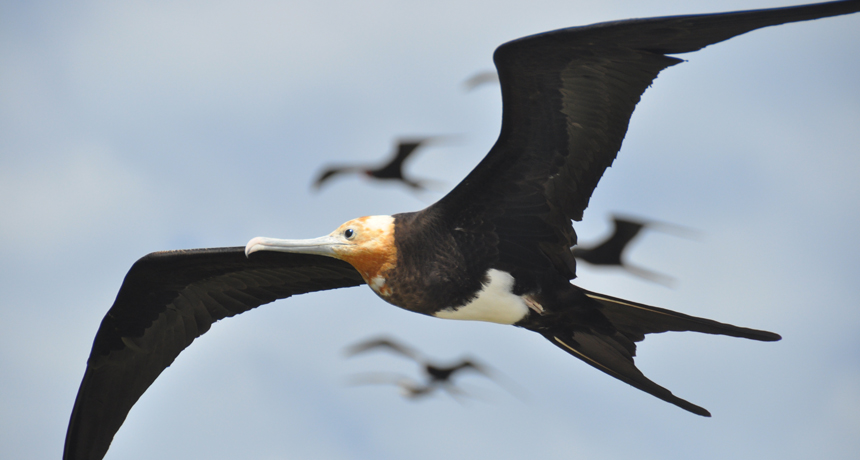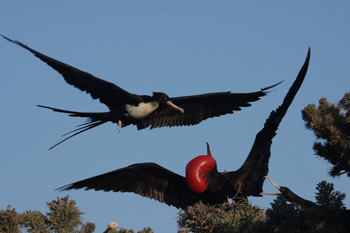Frigate birds spend months without landing
Upward-moving airflows help the birds stay aloft during long-distance flights

Frigate birds, even young ones like this one, ride air currents over the ocean to stay in flight for months.
AURÉLIAN PRUDOR/CEBC CNRS
Even the famous pilot Amelia Earhart couldn’t compete with the great frigate bird. Earhart flew nonstop across the United States for 19 hours in 1932. But the frigate bird can stay aloft up to two months without landing, a new study finds. This seabird uses large-scale movements in the air to save energy on its flights across the ocean. By hitching a ride on favorable winds, the bird can spend more time soaring and less time flapping its wings.
“Frigate birds are really an anomaly,” says Scott Shaffer. He is an ecologist at San Jose State University in California. Ecologists study the relationship between living things and their environment. A frigate bird spends much of its life over the open ocean. Frigate birds can’t land in the water to catch a meal or take a break because their feathers aren’t waterproof. That has caused scientists to question how the birds made their extreme journeys.
In the new study, researchers attached tiny monitors to dozens of great frigate birds (Fregata minor). The birds were living on a tiny island near Madagascar off of the East Coast of Africa. The monitors measured the animals’ location and heart rate. They also measured whether the birds sped up or slowed down on their flights. Everything from how often the birds flapped their wings to when they dived for food was recorded for several years.
Combining the data, the scientists re-created what the birds were doing minute-by-minute during their long flights. Both juvenile and adult birds flew nonstop for weeks or months, the scientists found.
Their findings appear in the July 1 Science.
Cloud travellers
The birds fly more than 400 kilometers (roughly 250 miles) each day. That’s about the equivalent of a daily trip from Boston to Philadelphia. They don’t even stop to refuel. Instead, the birds scoop up fish as they fly over the water.
And when frigate birds do take a break, it’s a quick stopover.

“When they land on a small island, you’d expect they’d stay there for several days. But in fact, they just stay there for a couple hours,” says study leader Henri Weimerskirch. He is a biologist at the French National Center for Scientific Research in Villiers-en-Bois. “Even the young birds stay in flight almost continually for more than a year.”
Frigate birds need to save a lot of energy to be able to fly so long. One way they do that is to limit their wing-flapping time. The birds seek out routes with upward-moving air currents. These currents help the birds glide and soar over the water.
For instance, the birds skirt the edge of the doldrums. These are windless regions near the equator. For this group of birds, that region was in the Indian Ocean. On either side of the region, the winds blow steadily. The winds come from cumulus clouds (the ones that look like fluffy cotton balls), which frequently form in the region. Riding upward-moving air currents underneath the clouds can help the birds soar to altitudes of 600 meters (about a third of a mile).
The birds don’t just stop there, though. Sometimes they fly higher. Airplane pilots tend to avoid flying passenger planes through cumulus clouds because the clouds cause turbulence. That is the chaotic swirling flow of air that can give airplane passengers a bumpy ride. But frigate birds sometimes use the rising air inside the clouds to get an extra elevation boost. It can propel them up to nearly 4,000 meters (2.4 miles).
The extra height means the birds have more time to gradually glide downward before needing to find a new draft that lifts them up again. That’s an advantage if the clouds (and the helpful air movement patterns they create) are scarce.
It’s not yet clear how frigate birds manage to sleep while flying. Weimerskirch suggests they might nap in several-minute bursts while ascending on thermals.
“To me, the most fascinating thing was how incredibly far these frigate birds go in a single flight,” says Curtis Deutsch. He is an oceanographer at the University of Washington in Seattle and not involved in the study. Another amazing thing about the birds, he notes, is how closely tied their flight patterns are to larger-scale patterns in Earth’s atmosphere. As these wind patterns shift with significant changes in Earth’s climate, frigate birds might change their flight paths, too.







